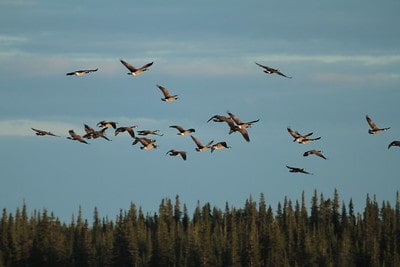Disclosure: We may earn commissions if you purchase products after clicking on a link from our site.
Are you in search of the best goose hunting tips available today? Do you want to take your goose hunting to another level? With these goose hunting tips, you will be more successful in hunting these birds.
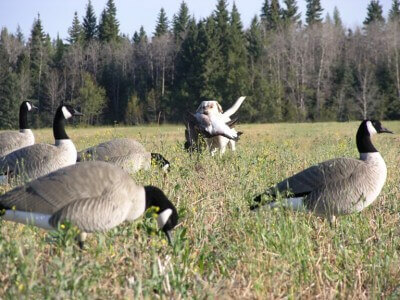
Best Goose Hunting Tips
1. Best Goose Decoy Set Up
According to Sean Mann, the best way to set up your goose decoys is to have them 10 feet apart and face them in random directions. This design provides a natural and relaxed look that offers incoming birds enough landing room inside the spread. This setup allows you to use fewer decoys which makes it easier to set them up and take them down.
2. Gun Maintenance
You want to keep your semiautomatic shotguns running in very cold conditions. Strip all the oil out of the action and moving parts with a firearm cleaner. Then spray the solvent into the action until it runs out clean. You then lightly lube all the moving parts with break-free clp. Apply this cleaning to the magazine tube also.
3. Succeeding With Snow Geese
Snow geese fly high and circle straight down, making it difficult to shoot them any other place but over a good spread. Tracy Northup suggests that you look out for snowy locations with ditches or hedgerows about a few hundred yards from the fields where you can creep into position to take down low-flying snow geese as they fly by without spooking the main flock.
4. Protect Your Hearing
You should take precautions to protect your hearing. You are vulnerable to hearing loss from shooting magnum guns with heavy loads. Earplugs are important when you are hunting.
5. Looks Are Deceiving
Don’t trust what you see 100% concerning how the birds fly. Canada geese seem to be slow in flight when compared to ducks. Pheasants, because of their long tails, appear to be slower than they really are.
To be successful in taking them down, swing your gun, lead the birds, and continue swinging as you pull the trigger. If you don’t do this, you will be surprised that you miss the target too often.
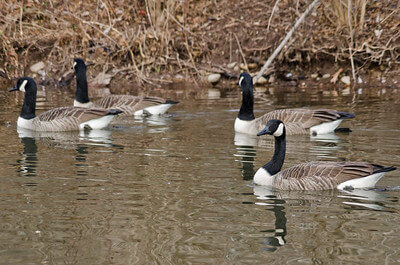
6. Shot Size
The best steel pellet for hunting Canada geese is BBs, while BBBs and Ts are better for longer ranges. Your pattern should deliver a minimum of 60 pellets in a 30-inch circle at the longest range you intend to shoot. Anything less than 60 pellets will not have the pattern density to ensure multiple pellet strikes in the goose’s vital areas.
7. It’s a Numbers Game
It is hard to pull large flocks of snow geese into your normal decoy spreads of just two or three dozen birds. Flying geese see very well at great distances and are looking for large groups of feeding birds. To have a good chance of pulling the birds into your spread, put out as many decoys as you can possibly get your hands on.
8. Move the Gun Slowly
When shooting geese, especially at long ranges, one trick that works well is to move the gun more slowly than you think is needed. You should swing slowly through the bird from behind and pull the trigger when you see some daylight between the barrel and the goose’s head.
Many hunters make the mistake of swinging too fast and trying to shoot too far in front of the geese. Just slow down and watch them fall from the sky. This is one of the best goose hunting tips that will bring a significant difference in your success rate.
9. Layout Blinds
If you use a layout blind, practice rising into a shooting position before they start flying. It takes time to get used to this move and the practice will serve you well. With little or no practice, you will find yourself in an awkward position with your face down on the gun during the first crucial seconds when it is actually the time to take the bird down.
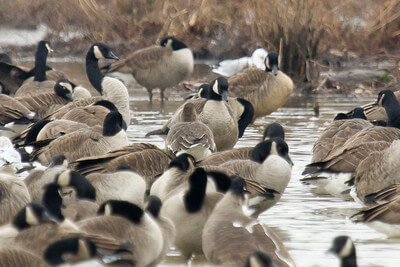
10. Never Pass Up Good Shots
When you have a situation in which the geese are right over your blind on a calm day and look down at you from 30 yards up, go ahead and take the shot. Its vital organs are exposed, thereby offering a good shot to take it down if you are using BBs or larger pellets. You might think the chance is gone, but you will never know until you take the shot. This is one of the best goose hunting tips to always follow through on.
11. Early Season Hunting
Canada geese are local birds and are not traveling to Canada. Hunting them in the early season is very rewarding, however; you will need to do your homework to find a place to hunt where the birds are feeding, resting, or flying past.
12. Try For Head Shots
Try for a headshot when geese are decoying at close range for a clean kill. The head of a Canada goose is a good size and the black-and-white markings on its head render it a highly visible target. A close-range shot to the head will take it down without a lot of pellets in the breast.
13. Below-Zero Weather
When it is very cold weather, it is best to get more sleep for an extra hour or two. When it’s cold, Canada geese will stay roosted and fly out to feed after the sun has come up and warmed the place up. They may leave the roost as late as 10 AM on these cold days and if you show up early morning, you only thing you will get at dawn is the brutal cold.
14. Angle Your Blinds
To get better shots in your blinds, always angle your blinds. If you are right-handed, position your layout blind slightly to the right of the landing hole. This will give you more shooting chances than if you were facing directly downwind. Left-handed shooters should be positioned on the right end of the line so they can intercept any geese that slide off on the left side.
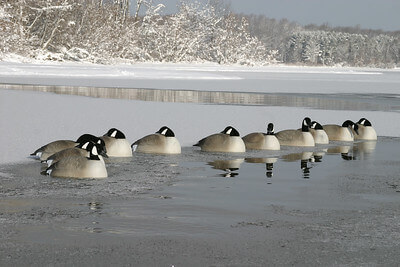
15. Silhouette Geese
When you are using silhouette decoys, carefully position them so that most of them appear broadside at every angle. The decoys will be visible to the flying birds.
16. Take Care of Young Retrievers
It is good to slowly bed a young dog by starting him out on doves and ducks. Then introduce him to geese only after a year of duck hunting. Go out in the field with him, pick up the bird, and encourage him to take it from your hand if he shows any reluctance to retrieve a goose. You can read the best duck hunting tips to help improve our duck hunting skills.
He will overcome his hesitancy and start retrieving geese. You don’t want him to have an unpleasant experience that might diminish his enthusiasm for goose hunting.
17. Hunting From Layout Blinds
When hunting from a layout blind, you don’t have your face down, thereby missing part of the sight of flying birds on their way in. Instead, you are viewing the whole spectacle from the time the birds appear in the distance to the time they come right into your face.
You can learn how to deer hunt in ground blinds to improve your hunting skills. We also reviewed the best hunting ground blinds to help you choose the right one for your hunting needs.
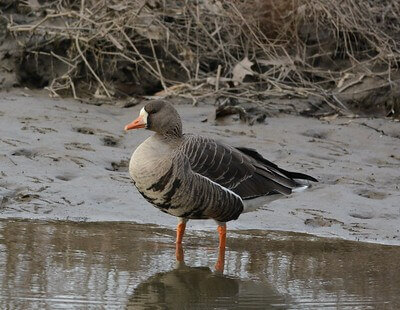
18. It’s the Little Details
When you are making your hunting setups, pay attention to those little details to make them as natural as possible. Add stubble to blinds as needed during the hunt. Pick up spent shotgun shells and look for anything out of place that might make the geese alert to danger. Doing this can get you closer to a successful goose hunting season and it is one of the best goose hunting tips to remember.
19. Concealing Your Boat
With the introduction of synthetic camo material, you can easily hide your johnboat or canoe. The material imitates different shades and textures of marsh grass and comes in sizable mats that you can attach to your boats.
20. Layout Blind Concealment
You may not have dozens of full-body decoys to provide the concealment needed to hide several layout blinds. You can conceal your layout blinds, if you are using a small spread of three to four dozen decoys, is to dig the blinds in with the permission of the landowner. It lowers the profile of the blind and conceals it from the geese.
21. Incoming Geese Illusion
Don’t be fooled by the movement of wild geese to a blind. It may seem that they are a hundred yards away when they are actually two hundred yards out. It may seem like they are just fifty yards away when in reality, they are a hundred yards out.
22. Pass-shooting & Jump-shooting
Pass-shooting and jump-shooting are effective hunting methods for geese although most Canadian geese are taken over decoy spreads. Pass-shooters scout to find where geese are entering and exiting a feeding field, then they position themselves in cover beneath the flight lanes. You want to hide as close to a feeding area as possible to intercept low-flying birds.
Jump-shooters use covers like thickets and fencerows as well as other geographical features to get within range of feeding geese and shoot them when they are flushed. You will need to have a good strategy, patience, and good concealment to be successful with these hunting methods.
23. Different Styles of Goose Calls
It is recommended to have two different styles of goose calls. One can be an acrylic short-reed goose call that produces a very loud, sharp, and high-pitched tone for the field and windy days. The other can be a wood short-reed goose call that produces a softer, deeper, and more realistic sound according to Fred Zink.
24. Follow the Leader
There should be a leader for every hunting group. Usually, it is the most experienced hunter or caller is chosen as the leader of the hunting party. He monitors the geese’s work and determines when to call, flag, and shoot. The leader helps other hunters remain concealed and the hunt progresses smoothly and safely by him calling and shooting for the group.
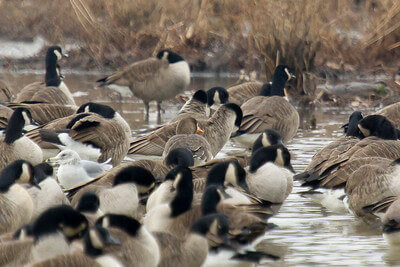
25. Windy Day Hunt
On windy days, Canadian geese land shot and out of the wind. Set up out of the wind in low areas of fields, behind trees, or on hillsides. When the wind is blowing, geese will always look to get out of the wind. Additionally, call loud and aggressively. Use aggressive notes and put in a lot of volume as opposed to calling more.
26. Finding the Feeding Sources
Canada geese will return to the area where they were feeding the previous afternoon in the morning. This pattern makes scouting all the more important. When you locate a feeding flock, wait until they fly back to roost before you go into the field to identify their feeding area.
Look for fresh droppings and when you find them, take a GPS reading or mark the spot to make it easy for you to identify them when you return there the next morning in the dark.
27. Decoy Motion Is Crucial
Don’t use a large number of full-body decoys when you are hunting a sandbar or other water set. With decoy spreads, movement is very important. Try to reduce the number of full-body decoys and use more floaters if there is a current.
28. Try To Keep Decoys Frost Free
On cold and clear mornings, frost can pose a real challenge for goose hunters. Decoys can frost up pretty quickly and when the sun rises, they will shine and flare the geese. To minimize the frosting of your decoys, get every other thing set up and ready before you set out your decoys right before shooting time.
Tasks like brushing up your blinds, and organizing your guns and gear should be done before you set out the decoys. The less time the decoys have to accumulate frost before sunup, the better for you.
29. Goose Calling
Learn to call with a lot of volumes, but it is also important to learn how to call softer. Learn to call like a live goose that is communicating with other live birds in the air.
30. High-Flying Geese & Your Blinds
There are times when your hunt is ruined when it is little or no wind and high-flying geese come straight over your spread, seeing your blinds. To prevent this from happening, place six of your decoys about 50 to 60 yards downwind or in the direction they are coming, and place the decoys in two groups on either side of your spread.
This will make the birds focus on the decoys and start dropping even though these decoys will be out of shooting range. Wait until they commit before you start calling. Then be prepared to call and flag aggressively to prevent them from short-stopping. Once they are past the downwind decoys, call as much as is needed to keep them on a string.
31. Geese Lie Down
Geese will lie down after touching the ground if the temperature is below 20 degrees or if the fields are full of ice and snow. You should mimic these geese’ behavior with decoys.
You should replace full-body decoys from their bases and place them directly on the ground or use shell decoys to mimic this look. You can also “root up” dirt and stalks among the decoys to give the impression that birds have been actively feeding.
32. Decoy Spread Balancing
You should always balance your decoy spread. According to Vance Stolz, he states that regardless of the size of your spread, it should have 80% feeder and 20% “active” decoys. Most of the feeders should be grouped upwind of where you want them to land, which should be near the spread’s center.
Next, place the active decoys downwind of this group to look like birds that have just landed and are moving toward the feeders. Have some actives positioned around the outside of the spread in small groups of three to seven decoys?
Additionally, you can also position lines of feeders to mimic geese that are competing for some food source. Always watch the birds in the fields when scouting and set your spread to imitate them.
33. Flagging When Foggy
On calm and foggy days, try to listen and use a flag instead of calling when you hear geese, not when you first see them. This trick is effective when they are close and are coming toward your spread.
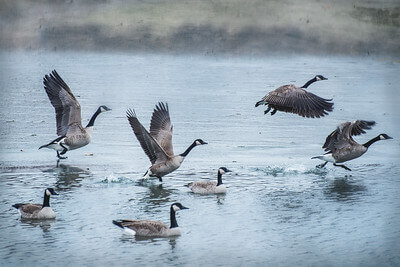
34. Always Spice Things Up
As the hunting season goes on, freshen up your decoy spread by altering the number of decoys as well as their configuration. Observe how the birds react to the changes you make to your decoy spread. If they are responding the way you expect, change up the spread.
If you hunt the same area with the same spread and configuration, the local geese will notice it and avoid your decoys. Always be changing and observing.
35. Land-and-Water Spreads
Set up land-and-water spreads when you are “running traffic” for Canada geese. Employing a combination spread of sleeper shells, full-bodied and floaters can be very effective.
36. Set Decoys Close To Good Cover
When you are placing your decoys in open fields or pastures, always keep concealment first and foremost. You will have more success getting more birds by hunting where you hide. Be on the lookout for rows of tall grass, piles of crop stubble, or a dip in the terrain where you can conceal layout blinds.
37. Communicate With Decoy Placement
Set up your decoys to send a number of messages about the flock on the ground. The messages communicated from the decoys are about where the food is located in the field, where the food is not located, and where the safe spots are. Feeder decoys send the message that food is at the goose’s location.
A group of active decoys drives the message that there is no available food in the area as geese like to land as close as possible to food sources. Rester and sleeper decoys indicate safe areas. Sleeping geese decoys sends the message that the area has been checked out and is safe to drop in and take a nap.
38. Don’t Overcall
Many goose callers make the mistake of overcalling. They mistake speed and volume for emotion. You will have to remember that calling is more art than science. You will have to learn how the birds are responding to your calling and always make adjustments to continuously improve. Perfect the art of conveying a message in your calls.
39. Be the Contrarian
If you are hunting in an area with a lot of hunting pressure, don’t try to match out the decoy spread out in the fields, especially during the late season. If everyone is using bigger spreads, resort to one or two dozen decoys and do the calling. You want to stand out from everyone else and giving your spread a different look is how that is accomplished. Curiosity kills geese.
40. Calling On Big Water
Geese have the luxury of many potential landing spots on big rivers, lakes, and marshes. You will have to capture the attention of flocks of geese moving at long distances and draw them closer to your spread. You will have to call loudly and continuously if the wind is high or the geese are flight birds.
You should tone the calling down as they come closer. When the wind is calm or if the geese are locals coming off a refuge close by, reduce the noise and call with more discretion rather than force.
41. Passing Geese
When geese are going long distances, you want to capture their attention and get them to come your way instead of flying to their next destination. You accomplish this by calling with loud, continuous honks, clucks, and moans.
Do calls with loud, high-pitched calls that crack between low and high notes. You continue calling them until they come your way or fly out of earshot.
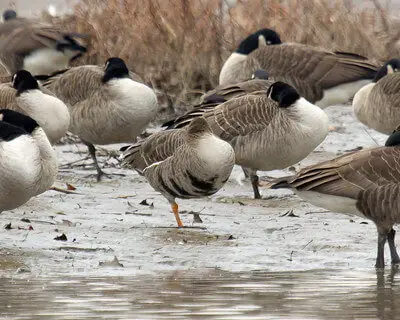
42. Multiple Callers Working Together
More “pulling power” can be placed over a flock of geese by multiple callers than just a single caller. This doubles or triples the notes thereby increasing the excitement and attraction of the passing birds.
The callers need to work together for the calls to sound as natural as possible. The callers should practice calling together to synchronize their cadences and learn to avoid just piling notes on top of each other. There’s more to it than just many callers calling and making noise. There’s a method and strategy to the madness.
Always remember that too much calling can spook the birds. If you have a situation in which a flock flies away, one or more callers should quit calling to minimize the pressure.
43. Shifting Calls
When you have been successful to capture the attention of flying geese and they turn your way, shift from loud calling to “ground talk” that they make when on the ground. “Ground talk” includes murmurs, moans, and clucks.
While you are doing these, monitor their reactions. If they start to leave, get back to more excited, aggressive honks and clucks. If you are successful and they turn back toward your calls, tone it down again.
44. Use Comeback Calls
If Canada geese approach your decoy spread but then start to fly away, use comeback calls to persuade them to return. You can use any form of enthusiastic calling such as moans, clucks, and split notes.
The Bottom Line
Hunting geese is fun and exciting but also has its own challenges. With these goose hunting tips, you will take more geese home whether you are a beginner goose hunter or have been hunting geese for many years. If you also hunt deer, the best whitetail deer hunting tips will help you take more deer home during the hunting season.
You can also read the best turkey hunting tips, how to hunt teal, and the best duck hunting tips if you hunt these other birds.
